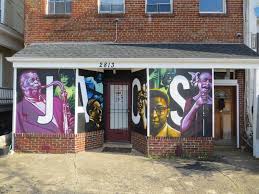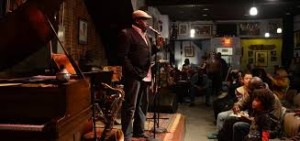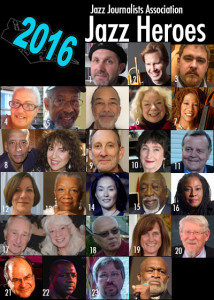In Washington DC for events surrounding the investiture of vibist Gary Burton, saxophonists Pharoah Sanders and Archie Shepp and Jazz Foundation of America‘s executive director Wendy Oxenhorn as National Endowment of the Arts’  Jazz Masters, I visited a new grassroots venue that shows where the deep heart of jazz support lies.
The Jazz and Cultural Society is an 11-month old community center in a largely African-American neighborhood now presenting music twice a week (Wednesdays and Sundays, 6-9 pm). It’s the love-child of Dr. Alice Jamison, who owns the building, and trumpeter, artistic director and building contractor DeAndrey Howard, who spent five years renovating the formerly dilapidated storefront into a friendly, intimate, nonprofit, alcohol-free,
soul-food-available space that hosts local bands and all-age (under 12, free) audiences. Admission is $5, sodas and waters cost $1, there’s a grand piano and Hammond B-3 organ onstage, perfect sight- lines and good sound, comfortable seating at tables.
About 50 people gathered last night to hear singer Tiya Ade, with pianist Vince Smith, bassist Tim Jones and a tenor saxophonist whose name I missed but who tore through Sonny Rollins’ “Sonnymoon for Two” and was appropriately gentle on “Old Folks.” Few listeners left during the set-break, when Howard, who had been playing drums, sat down to explain to me that he has strict ideas about programming: No smooth jazz, only true jazz played by musicians who are ready, and if anyone starts blowing something like Marvin Gaye’s “What’s Goin’ On” he walks up in front of them and casts a hard look.
DeAndrey has a long-term, go-slow vision for developing JACS’s presentations — a recent “Spoken Word” night drew a large crowd, on average younger than those usually in attendance. But whatever the age of listeners, JACS is clearly a hangout promoting socializing, relaxation and enjoyment of the original American art form.
After I posted notes to Facebook a couple days ago about President Barack Obama hosting International Jazz Day (April 30) at the White House — and also the Jazz Journalists Association’s celebrations for 27 “Jazz Heroes” in 23 U.S. cities — several commenters complained that IJD and other comparable events are top-down and not inclusive enough for the music as it really is (one “friend” even proposed that IJD is an act of jazz suppression, although the intent is to beam its big concert to 2 billion people, world-wide). My response was that initiatives like IJD and the Jazz Masters intend to reach beyond the hard-core jazz world to people who may have little knowledge, interest or access, and that if there’s not enough jazz in one’s locale, determined activism can change that.
Places like the Jazz and Culture Society — also Sistas’ Place in Brooklyn, Room 43 in Chicago’s Kenwood neighborhood and Elastic Arts in fashionable Logan Square, the Lilypad in Cambridge MA — prove that despite all challenges and impediments, where there’s a will there’s a way. Putting forth and preserving creative music has not been easy in the U.S. maybe ever, and increasingly less so over the past 50 years. But those of us who love to play and listen to it shouldn’t stop now. Our Jazz Masters haven’t — follow their lead.
howardmandel.com
Subscribe by Email |
Subscribe by RSS |
Follow on Twitter
All JBJ posts |



